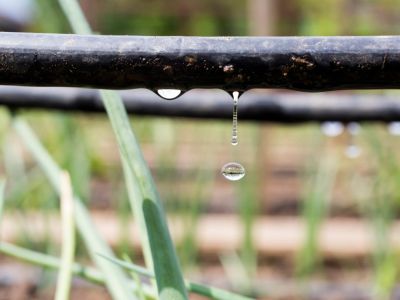Using Drip Irrigation Systems
Drip irrigation kits are available at most garden centers. They allow you to water plants separately with emitters, or water groups of plants with micro-spray stakes or tapes that ooze water along their entire length. You can enlarge the system as plants grow or as new plants are added. Drip irrigation is excellent for home use and easy to install. This highly efficient watering method consists of a system of nozzles that deliver small quantities of water at low pressure directly to where it does the most good, at the root zones of plants. Using drip irrigation can save 30 to 70 percent of the water used by overhead sprinkler systems. Consider a drip system for outlying shrub borders and raised planters, around trees and shrubs, and in narrow strips where conventional above-ground systems would result in water waste. Low-volume application of water to plant roots maintains a desirable balance of air and water in the soil. Plants grow better with this favorable air-water balance and even soil moisture. Water is applied frequently at low flow rates with the goal of applying only the water plants need. A soaker hose is a rubber hose with perforations or holes. It is most effective when it lies on top or slightly below soil level and mulch is placed over the soil and hose. You can install the hose in the spring and leave it in place all season. Use a drip irrigation system or soaker hose in gardens that need the most water, such as vegetables. Drip irrigation delivers water slowly and immediately above, on, or below the surface of the soil. This minimizes water loss due to runoff, wind, and evaporation. Drip irrigation can be operated during windy periods as well. Adaptable and changeable over time, drip systems can be easily expanded to irrigate additional plants if water is available. Regular maintenance inspections are needed to maintain system effectiveness just as with high-pressure sprinkler systems. During the growing season, periodically check and clean emitters for proper operation. Flush the system thoroughly after a break and repair it to avoid emitter clogging.
Improving Existing Sprinkler Irrigation Systems
If a sprinkler system is already installed, check it for overall coverage. Avoid frequent, shallow sprinklings that lead to shallow root development. Compact soils result in puddling and water runoff. If areas are not properly covered or water is falling on driveways and patios, adjust the system. This may mean changing heads to do a more efficient job. Bubblers are devices that emit higher flows of water in a circular pattern. They are useful for irrigating larger plants, such as roses and other shrubs, and for filling basins around newly planted trees or shrubs. Micro-sprays emit large droplets or fine streams of water just above the ground. They are available with nozzles in full, half, and quarter circle patterns that wet diameters varying from 18 inches (45.5 cm.) to 12 feet (4 m.). These devices are low-pressure but share characteristics with high-pressure sprinklers. Bear in mind, however, that sprinkler irrigation results in a greater wet-to-dry fluctuation in the soil and may not produce optimal growth results.
Proper Irrigation Practices for Small Gardens
If your garden is small, use a hose to apply water slowly at the base of each plant, avoiding the leaves and foliage. Incorporating small basins around each plant helps to concentrate water at the plant’s roots. Watering by hand is most effective when there are basins to fill up. New plantings need rapid, deep watering that is best done by hand. Once the soil has settled around new plants, the drip system can maintain moisture. Irrigate turf areas differently than shrub borders and flower beds. North and east exposures need less frequent watering than south and west exposures. Apply water to slopes more slowly than to flat surfaces. Examine these closely and correct problems in your irrigation system design. Proper irrigation practices can lead to major water savings. The best way to accomplish this is through the use of drip irrigation or soaker hose methods.
